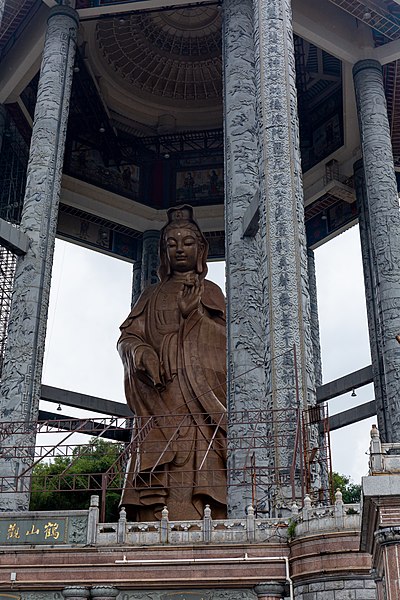Buddhism is the second largest religion in Malaysia, after Islam, with 18.7% of Malaysia's population being Buddhist, although some estimates put that figure at 21.6% when combining estimates of numbers of Buddhists with figures for adherents of Chinese religions which incorporate elements of Buddhism. Buddhism in Malaysia is mainly practised by the ethnic Malaysian Chinese, but there are also Malaysian Siamese, Malaysian Sri Lankans and Burmese in Malaysia that practice Buddhism such as Ananda Krishnan and K. Sri Dhammananda and a sizeable population of Malaysian Indians.
Rubbing of the Buddhist Mahanavika Buddhagupta stone inscription, 5th century CE, Penang.
Standing Buddha statue made from brass, found in a tin mine in Pengkalan Pegoh, Ipoh, Perak in 1931.
The Maha Vihara Buddhist Temple in Brickfields, Kuala Lumpur.
Kek Lok Si, or "Temple of Sukhāvatī", in Penang, Malaysia
The Kek Lok Si Temple is a Buddhist temple within the city of George Town in the Malaysian state of Penang. Located at Ayer Itam, it is the largest Buddhist temple in Malaysia and an important pilgrimage centre for Buddhists from Hong Kong, the Philippines, Singapore and other parts of Southeast Asia. The entire complex of temples was built over a period from 1890 to 1930, an inspirational initiative of Beow Lean, the abbot. The main feature of the complex is the seven-story Ten Thousand Buddhas Pagoda commissioned by the late Thai king Rama VI, featuring 10,000 alabaster and bronze statues of Buddha and the 36.57-metre-tall (120 ft) bronze statue of Guanyin, the Goddess of Mercy. The 10,000 Buddhas concept belongs to the Chinese Mahāyāna school of Buddhism while Rama VI was king over a Theravāda country and Buddhist tradition.
Kek Lok Si
The Guanyin statue with the pavilion in 2019
Statue of Guanyin, inaugurated in 2002 before the pavilion was built
Kek Lok Si Temple viewed from Air Itam








